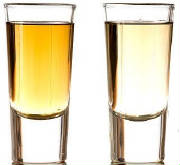Tequila, Mezcal
and Sotol are all produced from kinds of agave. There are said to be over 400 varieties. Despite
the plant appearance is not a cactus, Botanist are still debating the agave’s actual classification. A commonly accepted answer
is that the agave plant is a member of the lily family. The variety used in tequila production is known
as the blue agave.
The blue agave takes 8-12 years to reach maturity. At maturity, a tall flower stalk begins to sprout from the center of the agave, the
farmers the cut the stalk, forcing the sap to be diverted to heart of the plant, or ‘pina’. Tequila
can only originate within five designated regions of Mexico, being the entire state of Jalisco and specific areas in the
four states of Guanajuanto, Michoacan, Nayarit, Tamaulipas. To make Tequila, harvested pinas of the blue
agave plant are traditionally sliced into four pieces before being steam-baked in a stone oven. This converts the starchy sap contained in the
pina into sugars.
The sugary sap from the cooked pina is squeezed out of the pina and transferred with some of the agave fibres to white
oak vats, where water is added.
The higher proportion of agave, the better the flavor and aroma.  |